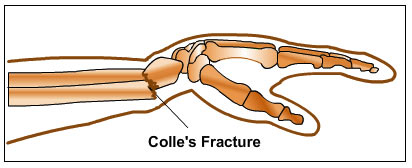
What do snowboarders and seniors have in common?
 What do seniors and snowboarders have in common? How about distal radius fractures, otherwise known as wrist fractures or Colle's fractures. It occurs when there is a fracture in the end of the largest forearm bone near the thumb and the carpal bones (small bones of the wrist). According to an online article:
What do seniors and snowboarders have in common? How about distal radius fractures, otherwise known as wrist fractures or Colle's fractures. It occurs when there is a fracture in the end of the largest forearm bone near the thumb and the carpal bones (small bones of the wrist). According to an online article:
A review of over 1.4 million U.S. emergency department visits found that hand, forearm fractures account for 1.5% of all visits. Of these, fractures of the radius and/or ulna comprise the largest portion (44%).
The majority of distal radius fractures occur as isolated injuries in the two distinct populations: youth involved in sports who sustain a relatively high energy fall, and seniors with osteoporotic bone who sustain a low injury fall. Petron MD, David (September 19, 2013). Distal Radius Fractures in Adults. Retrieved from http:/www.Uptodate.com/contents/distal-radius-fractures-in-adults.
What can you expect if you fracture your distal radius? The severity of the break, and the involvement of the surrounding structures impacts the treatment management. Possible treatment strategies may include:
- Splinting until the swelling diminishes
- Casting
- External Fixation/surgery (use of pins)
- Internal Fixation/surgery (use of plates to reduce/eliminate) the fracture
Can therapy help after a distal radius fracture? Absolutely! Therapy will focus on the following:
- Reducing swelling (for increased ease of movement)
- Pain management
- Appropriate range of motion exercises
- Strengthening exercises when appropriate
- Teaching strategies to help the patient adapt to his/her environment in order to increase functional independence
The orthopedic surgeons at MMI are able to provide excellent care when dealing with wrist fractures. MMI is also fortunate to have the expertise of hand surgeon, Dr. Kristin Nesbitt, to address complex/complicated wrist fractures. Additionally, MMI has four certified hand therapists, who are qualified to provide post fracture treatment with expert care.
Fall prevention screenings are also provided by MMI rehab. Results of that screen will help staff develop a plan for fall prevention. In the meantime, beware of winter's icy days and be careful when snowboarding!